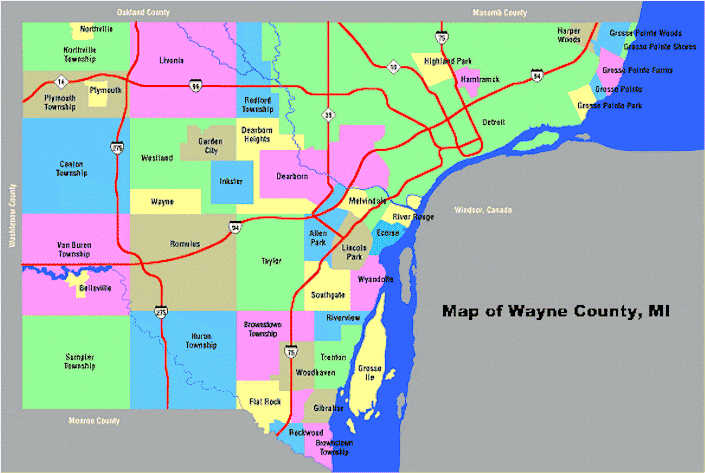Like 99% of the cities in the U.S., Detroit has two layers of government – City of Detroit and Wayne County – and we’ve been interested in how county government was holding up as the city government was flaming out.
Some of the key indicators are seen in the graphs that we posted yesterday (thanks to Steve Steffens), but so far, unlike its largest city, Wayne County is hanging on…if by its fingernails. It lost 240,000 people between 2000 and 2010, the number of people who moved out of Detroit.
It’s hard to imagine that Detroit’s filing for bankruptcy doesn’t stick negatively to all of the cities in the 539 square miles of Wayne County that’s not in Detroit. After all, we haven’t heard anybody ask how county government is doing since the bankruptcy was filed, which speaks to the way that the city at the heart of a region dominates media coverage and public perception.
It’s another reminder that it’s the large city that defines the reputation and the narrative for a region. No one talks about Detroit’s problems and adds: “But the suburbs are doing o.k.”
We’ve written extensively for several years about why Memphis is not the next Detroit. The differences in data are profound and dramatic, despite the cabal of Memphis haters that will probably ignore them anyway. They have a tendency for the facts to never get in the way of their opinions.
Some Lessons
There are lessons for all cities and regions in the collapse of Detroit:
* Risks to the financial health of governments should be dealt with when they are first identified. In the favorite parlance of the political class, “kicking the can down the road” is not merely delaying a decision. More to the point, the problem over time becomes a ticking bomb as the problem grows exponentially year after year, reaching a point where there is no longer a solution to it.
* The city’s reputation is critical to the economic development of the suburban towns and the region. Detroit has been in decline for decades, and there was the belief in the area outside the city that things would be fine for them even if Detroit failed. Not to be outdone, there was also derision inside Detroit for its own suburbs, and in the end, the lack of ambitious regional strategies exacerbated problems.
* It’s the city, stupid. Regions matter, but when investors and people are considering a place to live and work, they look to the health and vibrancy of the city itself. As a result, it’s in the region’s best interest to care about the city and its future.
* The major city dominates county government, and it’s in the enlightened self-interest of every one in the county to care about the future of the city at its core. In Wayne County, in the past five years, property tax revenues have declined by almost 30%, and it is estimated that it will be 12 years before 2008 revenue levels are reached again. The decline of Detroit is creating higher county taxes and taxpayers are paying more.
* All cities should swear off the self-hypnosis that is practiced when the truth would do better, particularly when it comes to economic development propaganda. As Detroit was falling apart at the seams, Wayne County issued a news release a week ago that it was chosen by Site Selection magazine as one of the 12 places “best to invest.” The basis for the award was that Detroit had added 10,582 jobs and $2.2 billion in capital investment in the previous year.
The EDGE
The Wayne County governmental structure is also a reminder that despite conventional wisdom here, our structure is exceedingly simple. Wayne County has 34 cities and nine townships in a county that is 100 square miles smaller than Shelby County.
Much in Wayne County sounds familiar, but primarily because few things are as trendy as economic development. Wayne County has its own organization called EDGE (Economic Development Growth Engine) and it predates the one here. It also has an aerotropolis, which includes Detroit Metropolitan Airport and Willow Run Airport and the 10-mile stretch of I-94 in two counties that connect them. It has 60,000 acres of land and involves the clustering of air commerce-linked businesses, office space, hotels, retail malls and recreation, around the two airports.
In addition, EDGE talks about the logistical strengths of Wayne County, its film and music ambitions, its biosciences and health sciences future, business accelerators and incubators, and technology. Meanwhile, the answer to the area’s economic woes was often seen in grand plans, including a $500 million light rail system that eventually morphed into a much less ambitious 3.3 mile streetcar system, while the underlying factors that drive the economy went unaddressed.
Now
In his state of the county speech, Wayne County Executive Robert Ficano could just as easily been speaking for Memphis and Shelby County:
“Our current system is based on property tax revenue that was radically reduced, virtually overnight. Our revenue disappeared, but our obligations did not, including numerous unfunded mandates from the state.
“We have a choice to make. We can work together to reform the way we fund local government services and put our finances on a solid and sustainable foundation. Or we can wait a decade for property values and those tax revenues to slowly rise again – and keep cutting services, keep lowering the quality of life for our citizens, and hope things get better someday.”
When it comes to problems in the public sector, there should be a single guiding principle: There’s no time like the present.





Excellent, Tom. The parallels are striking for Wayne and Shelby counties.
thank you for the shoutout!
Just yesterday, two Wayne County suburban school districts were just forced to dissolve for financial reasons. Now they are scrambling to figure out the logistics of beginning school in a couple weeks. It looks as though surrouning districts will be forced to absorb them.
http://www.freep.com/article/20130722/NEWS06/307220043/buena-vista-inkster-schools-deadline
Speaking of kicking the can, it reminds me of the tremendous bond debt during the Jim Rout years that we are paying for now.
Let’s get serious about fixing our finances, and proving to the world that we are creditable. I call out both city and county to abandon defined benefit pensions in favor of defined contribution plans. Make me a believer that govt works to serve the taxpayers rather than the legions of public “servants.”